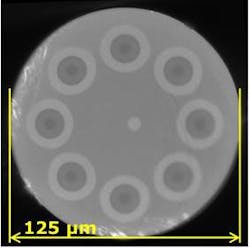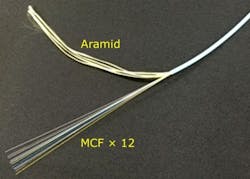At OFC 2015(Mar. 22-26) in Los Angeles, Sumitomo Electric Industries, Ltd. announced that it has developed a multi-core optical fiber including 8 cores in the standard 125-µm cladding suitable for optical data center interconnects, and claims to have realized an ultra-high-density fiber-optic cable with the highest core density ever reported. In a press statement, Sumitomo's scientists in Osaka, Japan reported the following:
"To cope with the growing data traffic in the short-reach interconnects used for parallel processing in supercomputers and resource disaggregation in data centers, optical interconnect technologies for broadband high-density transmission are intensively researched and developed. At the same time, the multi-core optical fiber (MCF) that has multiple cores in one fiber has been also intensively researched and developed. The MCF is expected as a next-generation optical fiber that can realize ultra-high-capacity transmission systems. Most of the ever-reported MCF developments had permitted the cladding diameter thicker than the standard 125-µm optical fibers to increase core count while realizing good optical properties of each core and suppressing core-to-core crosstalk.
RELATED ARTICLES
CommScope demos 100G wideband multimode fiber benchmark at OFC
Ethernet Alliance issues 2015 Ethernet Roadmap at OFC
Customized multicore optical fibers for reduced-size data cables
We developed, for the first time, an MCF that has a cladding diameter of 125 µm, equivalent to the standard optical fibers and includes 8 cores with low core-to-core crosstalk. The MCF also has optical characteristics comparable to the standard single-mode fiber (SSMF) specialized for 1.3-μm wavelength band where signal distortion can be suppressed. Having such features, the 125-µm cladding realizes the mechanical reliability equivalent to that of the standard optical fibers, and can utilize various technologies related to the standard optical fibers such as cabling and connecting technologies. The core count of 8 has been desired since full-duplex (2×) 100-Gb/s (4 × 25 Gb/s) signals can be transmitted over one MCF with a transmitting and receiving technology for the conventional 25-Gb/s signals. The realized optical characteristics have a high affinity to silicon photonics technology that realizes highly integrated optical devices operable at 1.3-μm band.
We fabricated a 12-MCF cable using the developed MCFs, in which 96 cores were included within an outer diameter of 3 mm. The achieved core density was more than 2 times higher than those of ever-reported fiber optic communication cables. We also evaluated the transmission characteristics in 1.3-μm band of the 1.1-km-long MCF cable. The evaluation test using 100G-ethernet (100GBASE-LR4) transceiver revealed that the MCF cable assures the error-free transmission for 800 Gb/s (8 cores × 4 wavelengths × 25 Gb/s) signals, which is 8 times higher than the SSMF case. The results of the transmission experiment indicate that the developed MCF cable has the transmission capacity no less than 9.6 Tb/s (12 fibers × 8 cores × 4 wavelength × 25 Gb/s). Improvements on transceivers can further enhance the transmission capacity.

